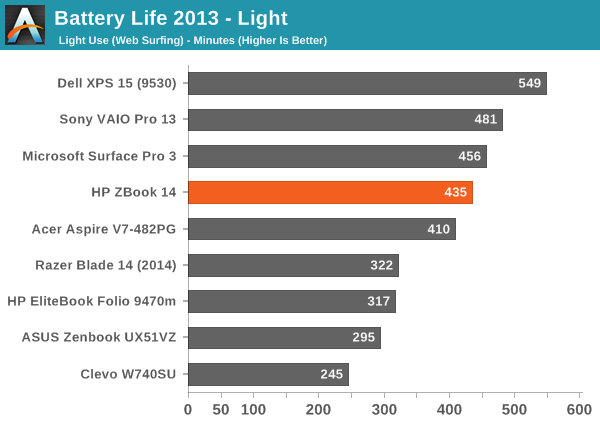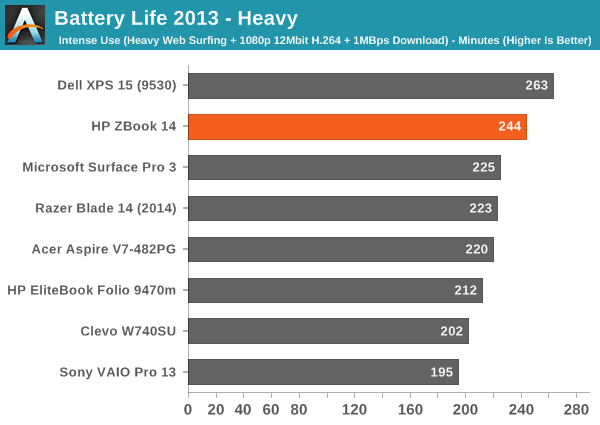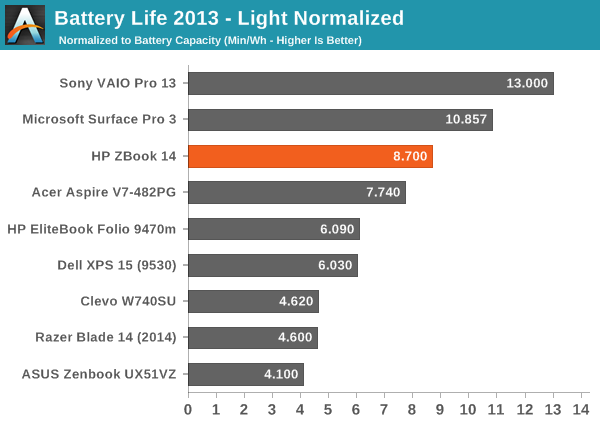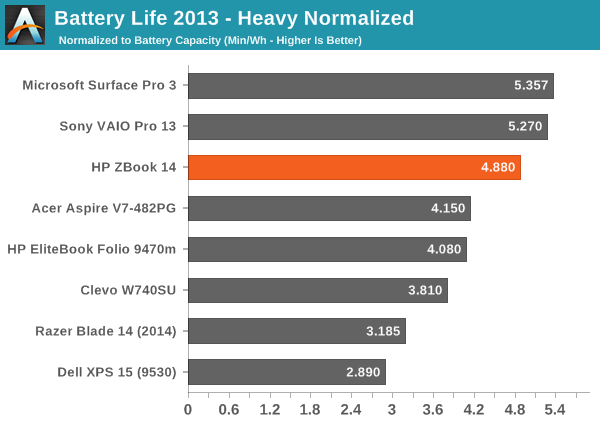HP ZBook 14 Review: Mobile Workstation Meets Ultrabook
by Jarred Walton on June 20, 2014 2:30 AM ESTHP ZBook 14: Battery Life
Our final benchmark is a test of battery life. Here's where HP runs into a bit of trouble, as the default software installation ends up negatively impacting battery life. I usually leave on the manufacturer utilities, but in this case HP has a security suite that results in about 15-20% less battery life. I ran the battery tests first with the software installed and then again after uninstalling, and the difference was quite dramatic. The problem is that some companies might actually like the HP software suite, and if so you'll just have to know you're going to lose out on some power savings. For testing, the LCD was run at 85% brightness (200 nits); we've switched our 1080p video and playback software for 2014, and as this laptop is running Windows 7 instead of Windows 8.1 we opted to use Windows Media Player as an alternative to the Win8 Video app.




Even without the extra HP software dragging battery life down, the results here are merely good and not exceptional. Seven hours of light use and four hours of heavy use might be enough to get you through the day, but more likely than not you'll want to bring along the AC adapter – just in case. As another option, HP does sell a slice battery that works with the ZBook 14, so you can sacrifice weight and thickness to basically double the battery life. The slice battery is also "intelligent" – the laptop will discharge the slice battery first and charge the integrated battery first, so you can potentially leave the slice in your bag and continue using the laptop when the power is drained.
Normalized battery life has the ZBook leading several other laptops, but at least the Sony VAIO Pro 13 and the new Surface Pro 3 maintain an efficiency advantage. Some of that might be due to the larger LCD on the ZBook, but while that could potentially narrow the gap in the Heavy workload, in the Light workload we're looking at a relatively large deficit.










66 Comments
View All Comments
MonkeyPaw - Friday, June 20, 2014 - link
I can wait a little while for the Surface 3 review, provided it is as thorough as an iDevice review. If we've waited a month to get a 2 pager, then I might share your disappointment.The only thing I can think that may be causing the delay is that preview Surface 3s had some power management and pen bugs that MS promised to address, and Surface 3 just saw a significant Firmware update this week. Technically speaking, the retail Surface 3 just became officially available, so I'm willing to wait for the actual OOBE review.
nerd1 - Friday, June 20, 2014 - link
So I ended up having the SP3 in my hand, BEFORE reading *any* worthwhile review. It is downright absurd.... The power management issue is with connected stay, and shouldn't affect the battery test at all. I think anand just doesn't care too much for any non-apple products nowadays.dabk - Friday, June 20, 2014 - link
What ultrabooks actually have dedicated graphics? I've been looking for a decent one for ages now.JarredWalton - Friday, June 20, 2014 - link
ASUS has the UX302, Acer has had a couple versions of the M5 and now the V7-482PG -- I'm not sure if the V7 is technically an Ultrabook, but close enough. Lenovo also has the U430/U430P that I believe qualifies as an Ultrabook. There are some other "close enough" options including the ASUS UX51VZ, Razer Blade 14 (and the Pro), Gigabyte P34G/U24F, and I think Sony might have something with a dGPU as well. We could also toss in a few AMD-based offerings with APUs that can at least handle moderate gaming, but they're not generally as fast as discrete GPUs.Of the above, I'd say probably the Acer V7-482PG wins my pick for a current gaming Ultrabook. Dell's XPS 15 and the Razer Blade 14 are in the mix as well, if you don't mind going larger than 14", and the Blade 14 is clearly going to be faster than the others. Personally, I wish Razer had used a Maxwell 860M instead of the Kepler 870M, but whatever.
skiboysteve - Saturday, June 21, 2014 - link
Really informative comment. Thanks for posting this!dabk - Monday, June 23, 2014 - link
This is very nice, thank you.My main problem I guess is buying a computer for around/over $1000 which has a last generation graphics card though I have no idea if Acer is ever going to update to the 800 series. Would you know anything about this?
I would also point out that the current gen Lenovo U4XX no longer have dGPU and that Sony no longer has anything with a dGPU (if only the Vaio Z were still around).
The Blade and P34Gv2 are amazing though with prices to match.
quorm - Friday, June 20, 2014 - link
Please review the Gigabyte P34G v2.Tikcus9666 - Friday, June 20, 2014 - link
If the AMD A10 PRO - 7350B and others in this range had the graphics branded fire pro (will relevant features unlocked), I'd be interested to see if HP or Lenovo (or Dell if they ever made an AMD based system again) launched any entry level AMD based workstation laptop, at a fraction of the cost, as GPU features (granted not memory bandwidth) would be in-line with what is in this workstation, and i imagine the AMD A10 PRO - 7350B would be less expensive that the AMD FirePro M1400 (granted have not checked)artk2219 - Friday, June 20, 2014 - link
I believe you mean the fx-7500:http://www.cpu-world.com/Compare_CPUs/AMD_AM735BEC...
I kid though, honestly the only difference would be in the drivers for the GPU since the hardware is literally identical, maybe the "pro" is better binned and has slightly less leakage and slightly better thermals? I would be curious to see how much of a premium they would charge for the "pro" over the FX-7500. I'm really looking forward to those benchies, it should perform about like an A10-4600M on the CPU side, maybe a bit faster thanks to steamroller. Graphically I honestly dont know, different architectures and such with GCN being much more efficient, but the VLIW4 based GPU in the A10 has a 132 MHZ max boost advantage. Either way, bringing the performance of an older 35 watt chip down to 19 watts is pretty nice. We will see how those ULV I3's and I5's fare in comparison.
http://www.cpu-world.com/Compare_CPUs/AMD_AM4600DE...
JarredWalton - Friday, June 20, 2014 - link
We actually asked AMD if the Pro APUs would have any OpenGL enhanced drivers, and the answer is sadly, "No, they will not." Maybe AMD will pursue that with a future part, but honestly: professional OpenGL drivers are a huge upsell on pricing, and the last thing AMD/NVIDIA want to do is to give people a $100 part that kills the sale of a $500+ part. I'd love to see some other competitor disrupt the industry, but so far it hasn't happened. Intel might be our best bet, as they have no existing market in professional graphics to protect, but first they need to create hardware that can handle the task.